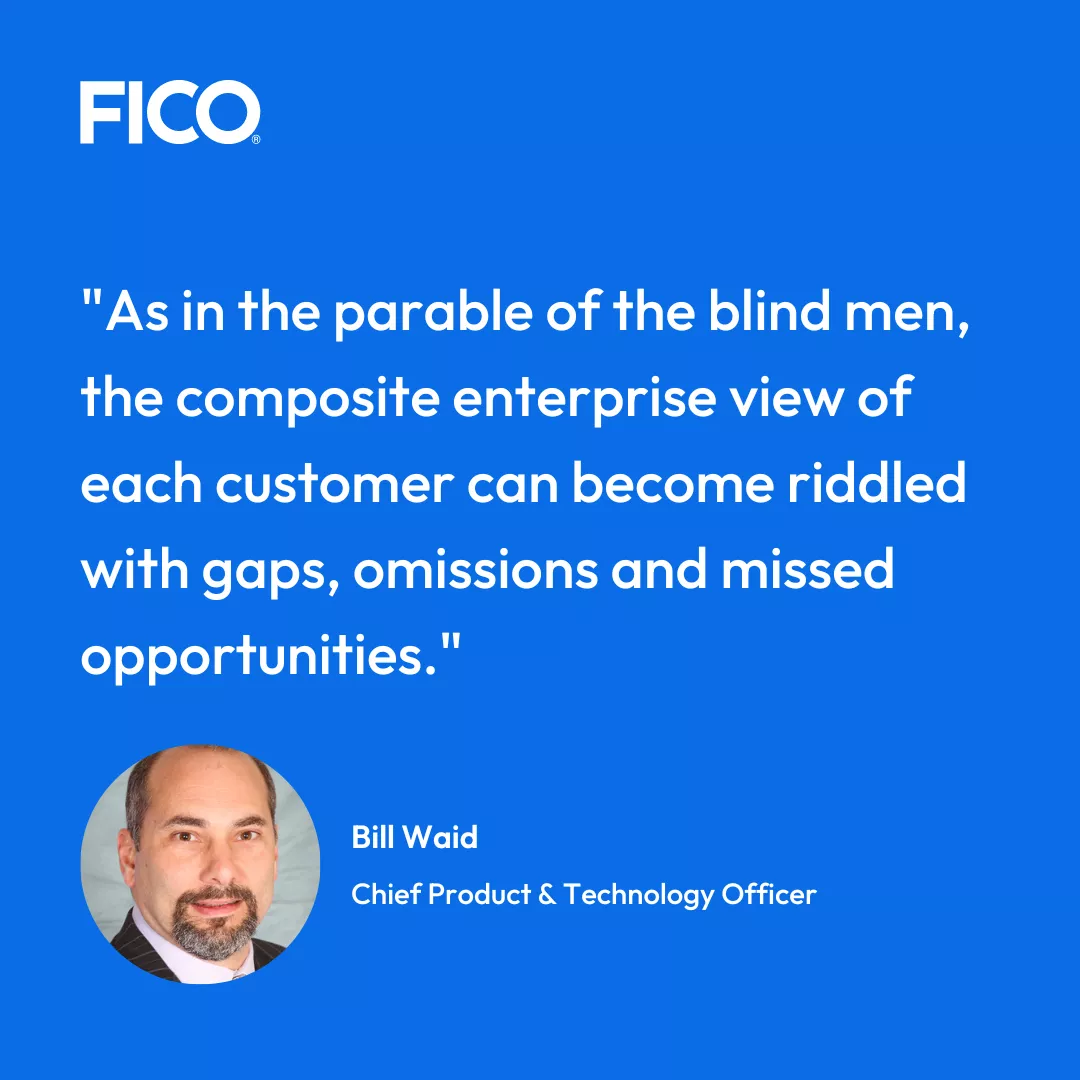How to Solve Your “Elephant Problem” with an AI Platform
Collaboration is critical to overcome the silos in your organization, each of which sees a partial picture of your customers

I just returned from India where I was traveling for business. I enjoy my visits there; India is a bustling tech epicenter that’s passionate about innovation and digital transformation, as well as a country rich in history and folklore. There’s one old Indian parable in particular, “The Blind Men and The Elephant,” that should resonate with every businessperson and technologist who is responsible for their company’s digital transformation, customer centricity, and user experience efforts.
As the story goes, an elephant was brought before a group of six blind men who frequented the village square. Curious, they each touched a different part of it — the trunk, tusk, ear, leg, side, and the tail — and in doing so, each formed their own unique idea of “what an elephant is.” Depending on which part they touched, they concluded that the elephant resembled a snake, spear, fan, tree, wall, or piece of rope… and they even argued amongst themselves about who was right.
The truth is, they were all correct within their own limited experience; and yet all were also wrong, having formed conclusions based on incomplete information. It was only by collaborating and combining their knowledge that they gained an accurate understanding of what an elephant truly is. Collaboration was their key to complete understanding… just as it is to a successful digital transformation.
The Digital Transformation “Elephant Problem” at Banks and Insurance Companies
Many large banks and insurance companies turn to digital transformation when they realize they have an “elephant problem.” That is, even with digital technologies, automation and analytics, they still don’t have a thorough understanding of who their customers are, and how to best serve their needs, because they cannot triangulate — or collaborate — on those needs… let alone build a compelling, unified customer experience to address them.
The problem is, as with all digital transformation efforts, part technological and part organizational: to promote accountability and P&L responsibility, most major banks and insurers are structured as semi-autonomous lines of business. Banks are often organized and automated around their mortgage, personal loans, HELOC, wealth management, credit card, and other business lines; similarly, insurers might be organized around a combination of home, auto, motorcycle, boat, RV, life, disability, medical, dental, and other business lines… and they applied digital technologies and technology solutions as needs arose.
Over time, companies automated their business lines’ operations one-by-one to maintain detailed, online records about those specific customers, without a future vision of sharing records between business lines or forming a customer-centric view, the end goal of digital transformation. As each business line automated, they amassed large volumes of data, but it all resided in separate “silos” of automation. Business lines were content with this arrangement, but it lacked innovation, didn’t serve the company’s interests at-large… and it certainly didn’t provide the most ideal customer experience.

The problem was that customers view their bank or insurer as a single, holistic entity with which they might have multiple types of accounts; but the inverse isn’t true: when business lines maintain a separate view of customers, there’s weak linkage between siloed, departmental systems in the back end… and thus little basis for cross-organizational collaboration despite the occasional use of digital technologies.
When every business line maintains its own digital technologies and the resulting siloed point of view about customers and their needs, each may be satisfied with the status quo. But, as in the parable of the blind men, the composite enterprise view of each customer can become riddled with gaps, omissions and missed opportunities. In an age when customers are accustomed to seamless integrated user experiences in every aspect of their digital life — and expect the same from their bank or insurer — this lack of collaboration not only hinders digital transformation, it results in a dangerously unsatisfactory customer experience:
- Customers are not served thoroughly or consistently.
- Customer strategies are hit-or-miss because they weren’t based on the complete picture of the customer and his/her needs.
- Cross-selling opportunities are lost to more informed, nimble competitors.
- Customers find better alternatives elsewhere and defect.
Those last two points are particularly painful for traditional banks and insurers, and a key driver for digital transformation and the innovation it portends. When you look at most digital-first fintechs and insurtechs’ strategies, they aren’t trying to go head-to-head against banks and insurers, who have immense portfolios of products and services to offer. Instead, digital insurgents typically create niche mobile apps focused on a single product or service, to eat into traditional companies’ market share one bite at a time, while forcing them to fight a multi-front defensive war.
How an Artificial Intelligence Decisioning Platform Helps You See the Whole Elephant
Thus, for defensive and offensive reasons, it’s imperative that traditional banks and insurers turn their vulnerabilities to strengths by committing to digital transformation, customer-centricity, and truly compelling customer experiences. To do this, many are accelerating this process by turning to what Forrester Research calls “AI Decisioning Platforms”, enterprise software platforms that enable companies to fuse the power of AI with human domain expertise, to automate and continually improve innovation, collaboration and consensus decision-making.
An AIDP like FICO Platform provides the foundation for collaboration — holistically among people, processes, and technology — to aggregate all dissociated customer views across their organization, thus enabling banks and insurers to enjoy unprecedented innovation, unearth previously-concealed customer insights, and build unbeatable customer strategies. It serves to accelerate digital transformation by:
- Unifying disparate customer information across the enterprise — combining all the customer insights currently residing in loosely-connected departmental “silos” — to create the most complete, real-time view of every customer possible. This composite view is essential in formulating insights and strategies to deliver unbeatable customer experiences, available at runtime to support event-driven operations.
- Infuse that customer-centric view with real-world business domain expertise from front-line employees, supplemented by AI, machine learning, and algorithmic insights. Over time, this makes customer actions more and more targeted and precise, resulting in optimal outcomes that get better with every customer moment.
- Predict and pre-empt customers’ impending needs, to identify opportunities before they arise… and even implant needs in customers’ minds before it consciously occurs to them. This mastery of customer moments leads to higher customer satisfaction, retention, and lifetime share-of-wallet… the objective of digital transformation.
- Simulate, optimize, and verify customer strategies before you launch them. This increases the likelihood of achieving desired business outcomes and reduces the uncertainty inherent in ad hoc approaches.
- Delight customers with user experiences that show you know them, understand their needs, and value their continued loyalty. This elevates your business to the level of “trusted advisor”; more than just “a bank” or “an insurance company,” but a strategic partner, that works collaboratively as a member of the customer’s inner circle.
Collaboration and innovation across the enterprise is the key to unlocking customer understanding and insights that translate to sustainable competitive advantage. Armed with the customer-centric, composite view that their competitors lack, banks and insurers who enjoy the distinct competitive edge collaboration affords are able to provide precisely what customers want and when they want it… and maybe a tad sooner.
Learn How FICO Platform Can Power Your Digital Transformation and Boost Collaboration
- Explore innovation with FICO Platform
- Watch the video “FICO® Platform: Applied Intelligence, when and where it matters”
- Read the whitepaper “FICO® Enterprise Intelligence Network: Redefining the next generation of applied intelligence”
- See customers discuss their use of FICO Platform
- Read the article from The Journal of Digital Banking, “How Financial Services Leaders Are Using Enterprise Intelligence to Optimize Efficiency Ratios”
- Watch FICO Platform in action with the story of your everyday consumer, Digital Jane
Popular Posts

Business and IT Alignment is Critical to Your AI Success
These are the five pillars that can unite business and IT goals and convert artificial intelligence into measurable value — fast
Read more
FICO® Score 10T Decisively Beats VantageScore 4.0 on Predictability
An analysis by FICO data scientists has found that FICO Score 10T significantly outperforms VantageScore 4.0 in mortgage origination predictive power.
Read more
Average U.S. FICO Score at 717 as More Consumers Face Financial Headwinds
Outlier or Start of a New Credit Score Trend?
Read moreTake the next step
Connect with FICO for answers to all your product and solution questions. Interested in becoming a business partner? Contact us to learn more. We look forward to hearing from you.
